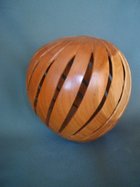The way these things eat timber is impressive. Anybody use one to rough out a form quickly either on or off lathe?
Last edited:

Yeah Stumpy Nubs (the YouTuber) has personal experience with a similar disk and mangled (but repaired) fingers to show for it, in one of his youtube videos, plus a safety video regarding angle grinders, which mentions or recounts several other incidents that have happened on Youtube and elsewhere.I consider woodturning as a test between myself and the wood. I enjoy the sound and accomplishment of proper shearing cuts. No way do I want an angle grinder wailing away throwing sawdust all over the shop. Wasn't there a story of a someone catching that chainsaw disc in the throat?
There was indeed -- a true story. A very narrow survival. I saw pictures years ago. Severe neck gashes and more. There is no way I would touch a grinder with a chainsaw disk mounted, even if the cord were not connected.I consider woodturning as a test between myself and the wood. I enjoy the sound and accomplishment of proper shearing cuts. No way do I want an angle grinder wailing away throwing sawdust all over the shop. Wasn't there a story of a someone catching that chainsaw disc in the throat?
 spswoodturners.org
spswoodturners.org
But if we don't share the stories of severe accidents and even deaths, newer users won't understand the dangers involved. AAW is supposed to be about education. There has always been a disclaimer in every AAW magazine about the dangers of this craft.In all fairness though, the accident under discussion had everything to do with the user. That tool and those wheels have been used by lots of folks without incident. Likely too much tool for the job (user error). Sounds like it was the first time he’d turned the tool on, at least with that wheel (user error, again). Work not fastened, one handed operation, sitting down (all user errors).
Imagine holding a log with one hand while cross cutting it with a chain saw held in the other. Bad things will happen, no fault of the saw. User error.
I feel bad for the gut who did this, hope he recovered well.
I think the lesson here is to be smart, not “bad, bad tool”. That’s too easy.
I felt that I needed to say what I did because all of the other responses, and in fact the original post said essentially, “bad tool! Don’t go there!”, instead of advising that one engages their brain, recognizes the dangers, and takes necessary precautions to keep themselves safe. It’s not the tool or manufacturers responsibility.But if we don't share the stories of severe accidents and even deaths, newer users won't understand the dangers involved. AAW is supposed to be about education. There has always been a disclaimer in every AAW magazine about the dangers of this craft.
Two capable hands. It’s up to a user to judge whether they have the hand strength to use the angle grinder.That tool is meant for use with two hands, the man being talked about was using just one hand and it got away from him.

